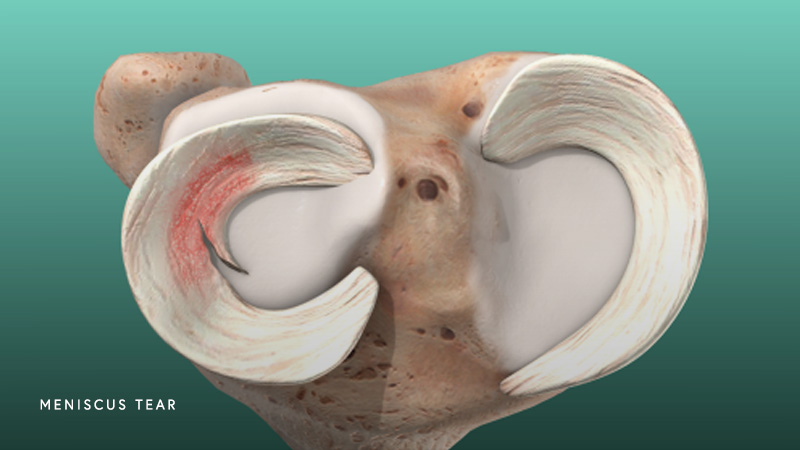Meniscus Tear
A meniscus tear is one of the most common injuries that occur in the knee. The meniscus is a form of cartilage found in the knee that cushions and stabilizes the hinge joint. A lot of weight is carried on the knee, making it a likely hub for injuries.
The knee consists of four bones: femur(thigh), tibia (leg), fibula (leg), and patella (kneecap), and four major ligaments: ACL, PCL, MCL and LCL. The two ligaments in the middle of the knee cross each other and are therefore known as the cruciates. On the inner, or medial side is the Medial Collateral Ligament (MCL) and on the outer, or lateral side, the Lateral Collateral Ligament (LCL). Between the femur and tibia are the meniscal cartilages, medial meniscus on the inner side, and lateral meniscus on the outer side. The quadriceps muscle, in front, attaches, by the quadriceps tendon, to the patella, which, in turn attaches by the patella tendon, to the tibia. When working properly, the quadriceps mechanism can straighten the knee and provide kicking power. The hamstring muscles attach to the fibula and the back of the tibia to help to power bending the knee.
A torn meniscus is among the most common knee joint injuries. A meniscus tear is known as damage to the meniscus cartilage of the knee. Tears can either occur completely through the cartilage itself or on the edges of the cartilage. Any activities that force an individual to forcefully twist or rotate the knee can lead to a torn meniscus.
Each of the body’s knees have two C-Shaped pieces of meniscus cartilage that act like a cushion between the femur and tibia. A torn meniscus usually results in immediate sharp pain, swelling, and decreased range of motion.

A meniscus tear can result from any activity that involves forceful and aggressive twisting or pivoting of the knee. A meniscus tear is most common in athletes, especially those involved in contact sports such as football or hockey. Sports that require a regular amount of forceful pivoting such as soccer, basketball, tennis, and baseball also put individuals at risk of tearing their meniscus. Obesity and increased age also increase the risk of a meniscus tear.
A torn meniscus can lead to knee instability, or the sensation of the knee buckling and giving way. Lack of range of motion and stiffness are also results of a torn meniscus. Persistent pain in the knee joint is common for those with an undiagnosed meniscus tear. Those with a meniscus tear are more likely to develop osteoarthritis in the knee joint. Common symptoms of a torn meniscus include:
- A popping sensation in the knee joint especially during bending or extending the knee
- Swelling
- Stiffness
- Pain when rotating the knee
- Difficulty straightening the knee
- Lack of range of motion
- Knee instability
- Knee locking in place
During the medical exam, the physician will move the knee and leg in different positions to test its range of motion. These movements also test for pain levels, stiffness, and swelling. The physician may also ask to watch the patient walk and squat in order to pinpoint the cause of the patient’s signs and symptoms.
If a diagnosis cannot be rendered during a physical exam, imaging tests will be ordered. XRays can help rule out fractures and breaks in the bone that may cause similar symptoms to those of a torn meniscus. However, an XRay will not reveal cartilage. MRIs use radio waves and magnetic fields to produce images of both hard and soft tissues in the knee, including meniscus cartilage. MRIs are commonly used to reveal meniscus tears.
Occasionally, a physician may use a tool known as an arthroscope to examine the inside of the knee. An arthroscope is inserted into the knee through a small incision. This device utilizes a light and small camera to transmit an enlarged image of the inside of the knee onto a monitor.
Treatment of a torn meniscus is entirely dependent on the severity of the tear. Some tears may only require the use of the R.I.C.E. method. The R.I.C.E. method requires a period of rest, icing for 20 minutes every 2 hours, compression of the knee joint, and elevation of the knee.
Medications including over-the-counter pain relievers and anti-inflammatories are commonly used to treat meniscus tears and knee pain. Physical therapy is another course of action taken in order to strengthen the muscles of the knee and improve overall range of motion.
If non-surgical treatments do not alleviate symptoms, surgery is often required. If a tear cannot be repaired, the surgeon will surgically trim the damaged meniscus through tiny incisions using an arthroscope.
For those with advanced degenerative arthritis of the knee, doctors typically recommend a knee replacement.
If you or a loved one are currently experiencing any symptoms related to a meniscus tear, contact the specialists of the Center for Orthopaedic Specialists. The Center for Orthopaedic Specialists have been treating those with meniscus tears in the Ventura County and Los Angeles area for many years. Contact us today!




 / 50 Reviews
/ 50 Reviews